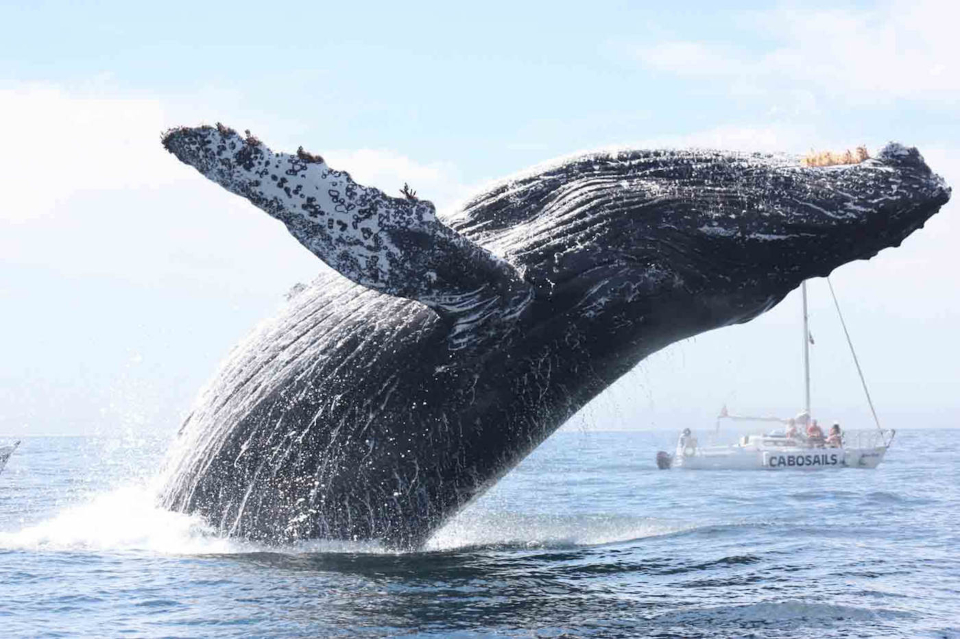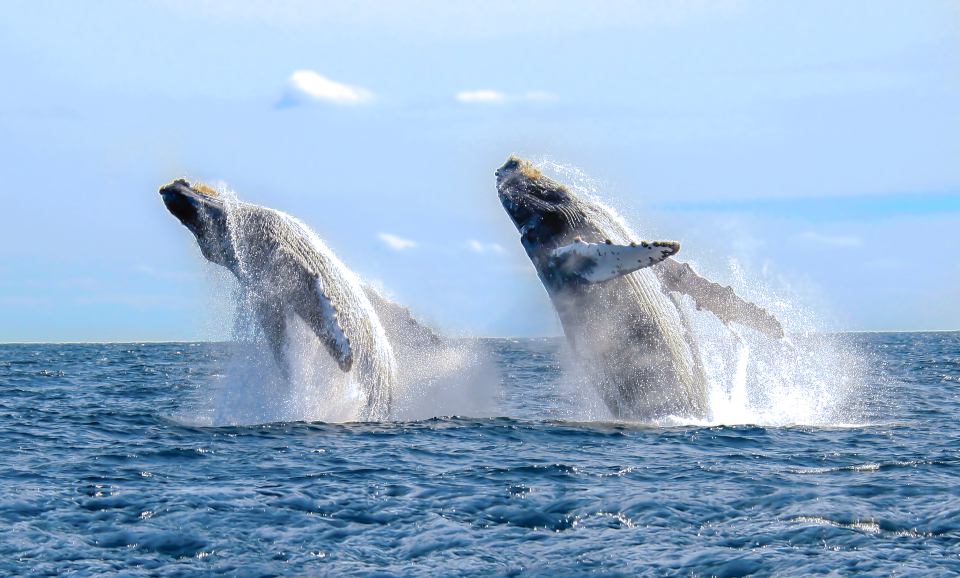It’s probably just a coincidence that tourists and the world’s largest creatures converge on Los Cabos each year at approximately the same time. We say probably, because let’s give the whales some credit. Who doesn’t want to spend winter in Cabo?
The truth is, the whales have been coming here a lot longer than the tourists. For as long as naturalists have studied them, in fact, whales have been migrating each winter from their arctic summer feeding grounds to wintertime breeding grounds in the coves and inlets of Baja California Sur.
Each species has their own breeding grounds of choice. Ojo de Liebre and Magadalena Bay on the Pacific Coast of Baja California Sur, for instance, are the favored breeding grounds for gray whales, while humpbacks continue on into the Sea of Cortez. Both species are commonly sighted in Los Cabos each winter, although humpbacks are more often seen; and because of their spectacular breaching behavior – in which they lift nearly their entire bodies out of the water (all 60,000 pounds or so) – much more of a focus of local whale watching tours.
From December 15, the official start date of whale watching season in Los Cabos, until April 15, the official end date, nearly every tour boat and activities company in the area offers some kind of whale watching experience. Some merely repurpose their sailboats, fishing boats or party boats for this seasonal occurrence, while others offer high-speed Zodiac inflatables that were purchased with exactly this purpose in mind; which is to say, chasing after breaching whales to get tourists as close as possible to the action.

But fact is, you don’t have to go on a whale watching tour to see whales. During winter months, and particularly during the height of the season in January and February, they can be seen from spots all along the coastline, from villas and resorts to beaches and golf courses.
Fun Facts About Whales and Whale Watching Season in Los Cabos
- Everything about whale watching season in Los Cabos is larger than life. Even the migration is out-sized. In fact, the longest migration in recorded history involves a gray whale–dubbed Varvara by scientists –who in 2015 completed a 14,000-mile round-trip journey from Russia to Cabo San Lucas. Not bad for a nine-year-old.
- No whales breach more spectacularly than humpbacks, and as luck would have it humpbacks are by far the most commonly sighted species in Los Cabos. But they’re not the only species by any means. Orcas are sometimes sighted, as are sperm and even blue whales, the latter being the largest creature ever to existed on Earth.

A rare “double” as humpbacks put on a show near Cabo San Lucas. Photo credit: Cabo Adventures. - The average life expectancy of a humpback whale is 45 to 50 years, and they are enormously intelligent, possessing a “spindle” neuron in their cerebral cortex that exists only in whales, dolphins, humans and great apes. The smartest whales, however, are sperm whales, who have brains five times the size of humans.
- Gray whales, the second most commonly sighted whale species in local waters, live an average of 70 years. So if Varvara’s trip from Russia to Cabo San Lucas is her normal migration and she does it every year of her life, she will have traveled approximately 980,000 miles.
- Some local adventure companies even offer hydrophones, so that in addition to the sight of these incredible creatures, guests can also listen to their haunting “songs,” a form of language so complex scientists are still working to achieve an even rudimentary understanding.
- Blue whales are the biggest, of course, and can grow to up to 100 feet long and reach 380,000 pounds in weight.
- Although all life on earth comes from water, whales – like other cetaceans such as dolphins – lived on land as recently as 50 million years ago, before evolving back into the sea.
- Whales can communicate over vast distances. A humpback singing in Los Cabos can be heard by other humpbacks thousands of miles away.
- Each whale species “speaks” not only their own language, but, like humans, communicates in different dialects based on region. A recent study of Pacific sperm whales discovered five separate clans, each one of which had their own unique dialect.
- A new whale species may have been discovered last month off the coast of Baja California, near the San Benito Islands. The recently sighted beaked whale – which neither looks nor sounds like any of the 23 other species of beaked whales – has been described as “big as a Clydesdale horse” and “rare as a unicorn”. This new sighting by the Sea Shepherd Conservation Society may explain why scientists heard a signal unlike any previously recorded back in 2018. Beaked whales commonly remain nearly 2,000 meters below the ocean surface, both for feeding purposes, and to avoid their foremost predators, killer whales (orcas).
- In a 2012 study, it was shown that beluga whales can actually mimic the human voice. So perhaps one day we can communicate with one another.
For now, though, simply enjoy “The Big Show”, coming soon to a Los Cabos coastline (hopefully) near you.
Want your business, activity or event featured and promoted by CaboViVO, please be sure to contact us here, thanks…
Saludos from Co-Founders…
Chris Sands – Writer and Michael Mattos

